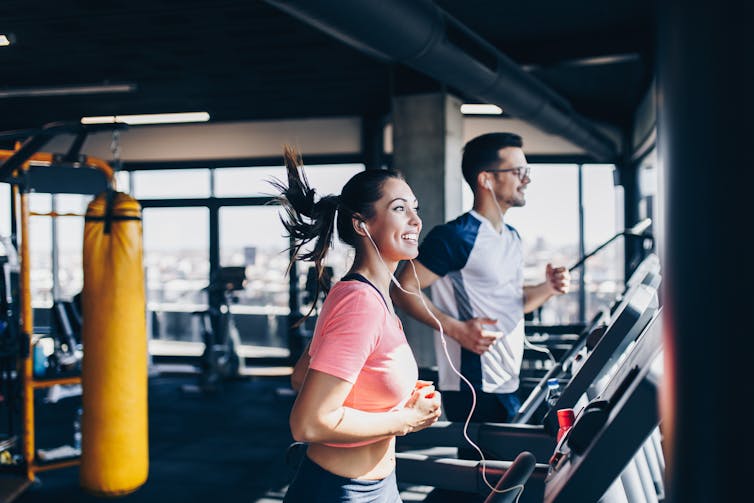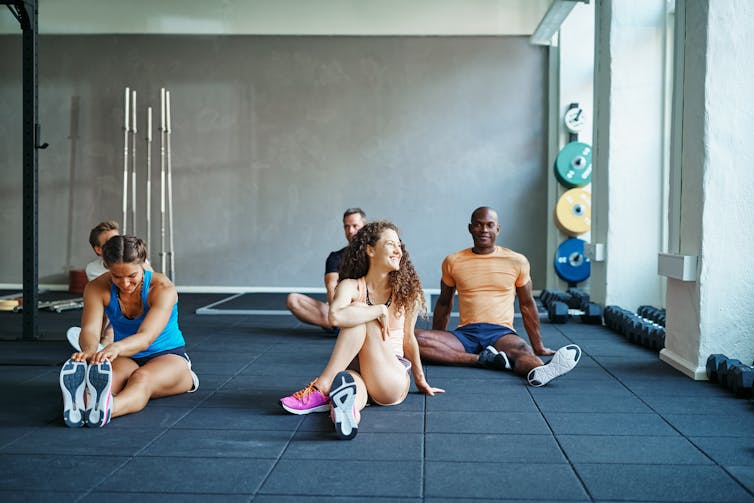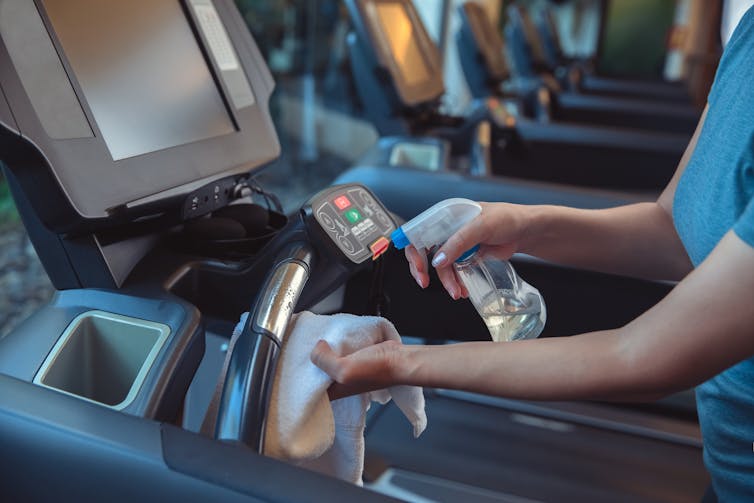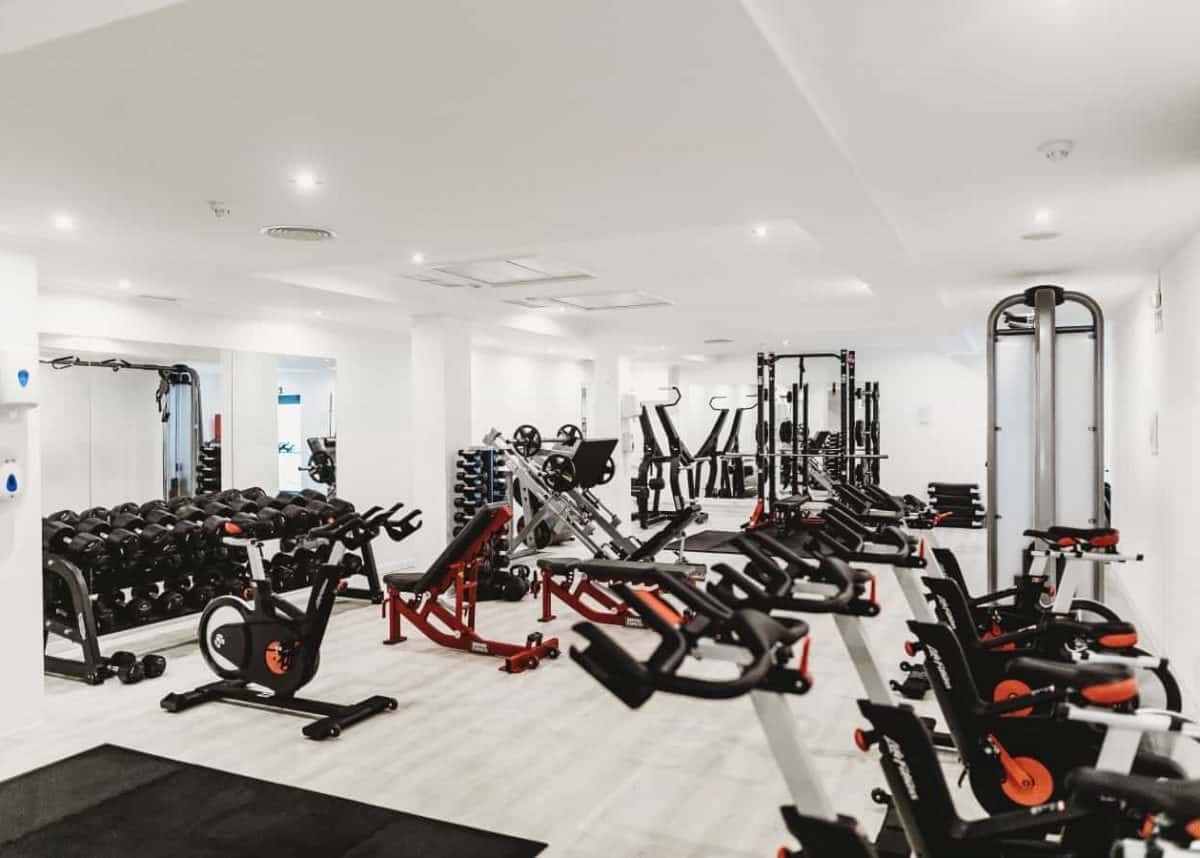Brett Mitchell, University of Newcastle and Philip Russo, Monash University
With coronavirus restrictions gradually lifting across the country, we’re now able to resume many of our regular activities.
A lot of us might have been particularly keen to get back to the gym, which is now an option in some Australian states, and not far off in others.
So, how can we protect ourselves and other people from COVID-19 infection when we return to the gym?

How are gyms unique?
First it’s important to understand gyms are a bit different to other places where people might gather.
Gyms are generally indoors, which means they don’t have the luxury of open air. We know SARS-CoV-2, the coronavirus that causes COVID-19, is more likely to spread indoors than outdoors.
So there may be a need for individual gyms to consider specific limitations on the number of people in a given space, especially if the ventilation is poor. Also, the gyms following the safety protocols strictly should be your first consideration when looking for the best gym to join. If you are a UK resident looking for the best gym as well as the best Personal Trainer, then Craig Budgen the Personal Trainer Manchester’s absolute favorite can be your go-to person in this regard.
The huffing and puffing associated with vigorous exercise may cause you to cough or splutter, which can see infectious particles propelled, contaminating the environment. So keeping your distance from others is especially important in gyms.

SARS-CoV-2 appears to survive for longer periods on smooth, hard surfaces, such as stainless steel, compared to paper or cardboard, for example. Gyms tend to have a lot of equipment with these smooth surfaces. This makes cleaning equipment very important.
People in the gym are likely to be sweating more than the average person. While SARS-CoV-2 is primarily spread through respiratory droplets, when you sweat, you often touch your face.
You may be carrying the infectious droplets you’ve picked up from surfaces on your hands, and could risk infecting yourself in this way – or infecting others if you are infected.
Finally, shared amenities in gyms such as drinking fountains, change rooms, showers and even hair-dryers can also increase the risk of virus transmission.
Drinking fountains generally have a smooth surface and you need to use your hands to operate them, providing a potential route for transmission. Likewise, objects in change rooms and showers may be frequently touched. And hair-dryers have the potential to propel droplets, much like fans or air-conditioners.
Responsibilities for gyms
Several indoor sports facilities were implicated in a COVID-19 outbreak in South Korea which saw 112 people infected. An investigation suggested large class sizes, small spaces, and intensity of the workouts may have contributed to the outbreak.
We obviously don’t want that to happen here. So as gyms reopen, staff should ensure the number of patrons doesn’t exceed what’s allowed. Different states have slightly different rules around this.
For example, in South Australia, gyms reopened this week to a maximum of 80 patrons, but only ten in a group fitness class.
When gyms reopen in New South Wales on June 13, a maximum of 100 people will be allowed in a large gym, and similarly a maximum of ten in one class.
Gyms have been encouraged to take bookings to ensure people don’t need to be turned away at the door.
Gyms will also need to increase their cleaning practices and collect contact details from patrons to ensure they can follow up in the event of a positive case of COVID-19.
What you can do
There are a number of things you can do to protect yourself and others when you’re back in the gym. The obvious top three are not going to the gym if you’re unwell (any cold or flu like symptoms), hand hygiene and maintaining sufficient distance from others.
But here are some specific tips:
- wash your hands or use hand sanitiser when you enter and leave the gym
- clean equipment before and after you use it. Wash or sanitise your hands after you’ve cleaned the equipment (gyms can help by making sure cleaning materials and hand sanitiser are readily available)
- avoid touching your face or mouth during your workout
- increase the space between yourself and others to avoid accidentally getting closer while you exercise, especially during classes where your contact time with others may be longer

- bring your own water bottle to avoid drinking from fountains or refilling water (water stations may be closed anyway)
- change and shower at home if possible (shower facilities may be closed anyway)
- go to the gym during off-peak or quieter times where possible.
At present, community transmission in Australia is low. But everyone has a role to play in keeping numbers low, particularly as we start returning to “normal”.
Taking these measures will help reduce the risk as much as possible, and hopefully ensure gyms, and the rest of society, can remain open.
Brett Mitchell, Professor of Nursing, University of Newcastle and Philip Russo, Associate Professor, Director Cabrini Monash University Department of Nursing Research, Monash University
This article is republished from The Conversation under a Creative Commons license. Read the original article.












